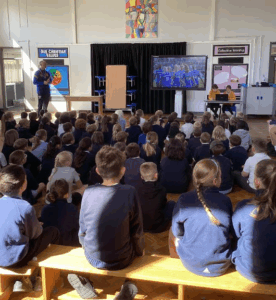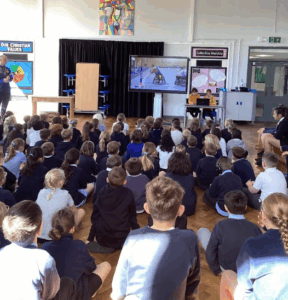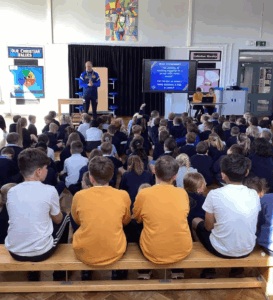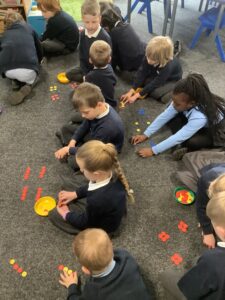Reading – Non-fiction Navigators
In Reading, we’ve turned our attention to non-fiction texts and the ways in which they help us to take charge! We’ve explored the differences between fiction and non-fiction and discussed their features.
Non-fiction can be read in any order to learn about a specific topic. Most non-fiction books help you to find your way around with some helpful features you wouldn’t normally find in a fiction book…
- contents – The contents page (sometimes called the table of contents) lists the sections of information in the book and where to find them, often with a page number.
- glossary – Usually found at the back of the book, the glossary contains key words related to the topic and their definitions. This can help with unknown, technical vocabulary.
- index – An index is an alphabetical list of all the topics covered in the book and where to find them. This helps the reader locate information quickly.
- subheading – A subheading is a bit like a signpost. It gives the reader an idea of what each section is about. It can also capture your attention – a bit like a mini headline!
We really enjoyed exploring some non-fiction books, using the features above to find information quickly and efficiently.




Help at home by exploring some non-fiction text with your child. Encourage them to navigate the text using the contents, index, glossary and subheadings.
A visit from Leeds Rhinos!
St James had a very exciting visitor from the Leeds Rhinos in today during our Collective Worship. Ian came in to talk to the children about teamwork and inclusivity – two key skills that help us to be happy and healthy in our school. We got the opportunity to learn about the different teams that Leeds Rhinos have, such as: men’s and women’s rugby; netball; a wheelchair rugby team and many more. The children responded really well when discussing the importance of inclusivity, teamwork and stereotyping, particularly in sport.
Ian also reminded us of the fantastic offer from Leeds Rhinos for pupils to go and see one of their matches! If you/your child is interested in this, discounted tickets can be purchased through school. Here are the details of the match:
Leeds Rhinos vs Hull FC
Friday 16th May
Kick off: 20:00




Living and Learning – I recognise the importance of sleep.
In Living and Learning this week, we’ve learnt about the importance of sleep; the things that help us to sleep and get a good night’s sleep.

A good night’s sleep can help us to feel:
- rested
- calm
- happy
- ready to learn
We discussed the importance of routine. A routine is a sequence of activities that is repeated. It helps us to know what to do and when – a bedtime routine can help our bodies and minds to get ready for sleep.
We explored the idea that different families might have different routines at bed time. These routines help us to mark the end of the day and get ready for sleep.
Sometimes, there are factors that can make it hard to fall asleep.
- busy body – jumpy legs, tummy ache
- busy mind – thinking, worrying
- surroundings – noise, screens before bedtime
- fears – dark, alone
Here are some good ways to relax at bedtime:

Help at home by discussing sleep with your child. What does bedtime look like in your house? How does your body and mind feel after a good night’s sleep? After a bad night’s sleep? What could you change to help you sleep better?
Arithmetic
This term, together with our weekly spelling test, we’ll complete a short, low-pressure arithmetic test every Friday. This well help us to grow as confident, flexible mathematicians.
Children will complete 15 questions on the 4 operations (+ – x ÷) before reviewing as a class. Papers will be sent home weekly.
Help at home by looking through the paper with your child, working through errors and offering similar questions for additional practice. If you have any questions or need additional support, please don’t hesitate to ask.
Welcome Back – Summer 1
We were delighted to welcome the children back to school this week to start our summer term. We hope you’ve had a happy and healthy break.
Here’s a look at what will be going on in our classroom:
English
In English, we’ll write a non-fiction report about a hero from history. We’ll read Amazing Grace by Mary Hoffman and dive into lots of interesting non-fiction texts.
Maths
In maths, we’ll learn about money, shape, length/height, stats and more!
Phonics – Spelling
We’ll continue our journey to becoming confident spellers…
Science
Science takes us back to plants, this time focusing on bulbs and seeds. We’ll plant some bulbs and observe them over time. We’ll also learn about sustainability and how we, as biologists, can support the wildlife in our environment.
Topic – History
This half term, we’re historians! We’ll learn about some heroes from history and the impact they’ve had on our society.
RE
How and why do some people pray? We’ll explore prayer across a range of world religions, linking to this half term’s Christian value, peace.
Living and Learning
We’ll learn about physical health: hygiene, sleep, diet, physical activity
PE
Throwing. Catching. Games. Exercise. Teamwork. Fun!
Help at home by keeping up the great work. Thanks for your all support so far this year – it’s had a huge impact. Please continue to use NumBots and Times Tables Rockstars, and listen to your child read every day.
Topic – D&T Cooking and Nutrition
Food preparation is part of Design and Technology; children have three opportunities each year to prepare food.
This term, the children made overnight oats using a variety of skills:
- snipping
- weighing (using digital scales)
- measuring liquids
- use measuring spoons
- claw chopping grip
- mixing
- arranging toppings
First, we read the recipe together, discussing some elements that might be changed. We also discussed hygiene and how we can stay safe in the kitchen.
The children enjoyed a great deal of success, building on previous food preparation learning.




Children took their food home to try then returned to school to evaluate the product. We considered the success of the product and how close it was to the recipe. We discussed challenging techniques and any changes we would consider for next time.
Help at home by watching some of these fantastic cooking videos. If you try any of these recipes at home, we’d love to see the results.
Maths – Division by sharing
In maths, we’ve been learning to divide.

This week, we’ve used the idea of sharing to help us to divide. When dividing by sharing equally, you’re calculating how much (or how many) each person (group) gets.
When dividing by sharing, it’s important to ask some key questions:
- How many are there altogether?
- How many groups are there?
We can use these questions to write our division equation.

The children really impressed me with their learning. We practised division by sharing using counters, saying these stem sentences to show our understanding:





Help at home by practising some division by sharing. We love this game.
Topic – Computing
This half term, we’re computer programmers!
Our current topic, computing, focuses on creating and debugging programs and algorithms.
An algorithm is a sequence of instructions or a set of rules to get something done.
The children have really impressed my with their ability, skilfully tackling challenges on Scratch Jr.
As the weeks progress, we’ll each be designing and creating a quiz game, and evaluating its success.




Help at home by exploring our topic vocabulary with your child.
algorithm – a sequence of instructions or a set of rules to get something done
program – an algorithm or algorithms which can be run by a computer
to debug – to find and fix errors in algorithms
computer – a type of machine that can follow instructions and do useful things
command – an instruction that can be used in a program
You could try Scratch Jr. at home!
Living and Learning – Strong emotions
In Living and Learning this half term, we’re learning about emotions and friendships.
We’ve talked about recognising emotions in ourselves and others and the benefits of speaking openly about them.
We discussed 6 key emotions
- Happy
- Excited
- Tender
- Scared
- Angry
- Sad
Empathy
What is empathy? Empathy is being able to know how someone else is feeling, even when you aren’t in the same situation. Sometimes we call empathy being able to “put yourself in someone’s shoes” and see things from their view.
We explored some situations in which children may have different emotions to one another. It’s important to be respectful of those emotions and acknowledge the importance of sharing them. Keeping feelings to yourself can have a negative impact on your mental wellbeing.
Where can I go for help with my emotions?
- talk to a trusted adult at school
- talk to a trusted adult at home
- talk to a friend
- put your worry in the Living and Learning box
Help at home by encouraging your child to express their emotions. Use the feelings wheel (above) to help. Compare the words in each segment of the feelings wheel – for example, does irritated feel different to furious?
Reading – The Lorax
In reading, we’re enjoying The Lorax by Dr Seuss. The Lorax is an engaging story with strong themes, told amusingly by way of rhyme. The children have enjoyed exploring the messages in The Lorax about environmental crisis and activism, building on our geography learning from last half term.
One of our favourite reading activities is ‘hot-seating’ in which children play the parts of characters from a story and answer questions. This is a brilliant platform for practising inference skills.
The children really impressed me; questioning, inference, acting – I saw it all!
We made sure to look the part…


Help at home by encouraging your child to think of some questions they’d like to ask characters in their favourite story. Take it in turns to step into character and have a go at answering the questions…
